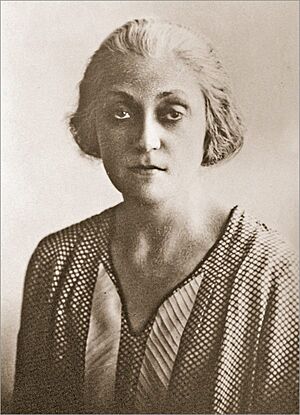Isidora Sekulić facts for kids
Quick facts for kids
Isidora Sekulić
Исидора Секулић |
|
|---|---|
 |
|
| Born | 16 February 1877 Mošorin, Austria-Hungary (modern-day Serbia) |
| Died | 5 April 1958 (aged 81) Belgrade, PR Serbia, SFR Yugoslavia (modern-day Serbia) |
| Occupation | writer, novelist, essayist, polyglot and art critic |
| Language | Serbian |
| Nationality | Serbian |
Isidora Sekulić (Serbian Cyrillic: Исидора Секулић, born February 16, 1877 – died April 5, 1958) was a famous Serbian writer. She wrote novels, essays, and was also an art critic. Isidora was the first woman to become a member of the Serbian Academy of Sciences and Arts in 1950, which was a huge achievement for women in Serbia!
Contents
Who Was Isidora Sekulić?
Isidora Sekulić was born in a village called Mošorin in what is now Serbia. She was a very smart student. Besides studying literature, she also learned a lot about science and philosophy.
She finished her teaching school in Budapest in 1892. Later, she earned her doctorate degree in Germany in 1922.
Her Amazing Life Journey
Isidora loved to travel and explore the world. She spent time in England, France, and Norway. Her trips to places like Oslo, Bergen, and Finnmark in Norway inspired her to write a thoughtful travel diary called Pisma iz Norveške (which means Letters from Norway) in 1914.
She was also a true language expert! Isidora could speak several old languages and nine modern languages. Imagine being able to talk to people from so many different countries!
What Did She Write About?
Isidora Sekulić's writings were often deep and thoughtful. She liked to explore how people think and feel in modern times. Her collection of short stories, Saputnici (meaning Fellow Travellers), was a very detailed and brave way for her to look closely at her own thoughts and feelings.
In her main novel, The Chronicle of a Small Town Cemetery (Кроника паланачког гробља), she wrote in a unique way. Instead of telling the story in the usual time order, each part of the book starts in a cemetery. Then, it goes back to show the lively moments of life, with all their happy and sad parts.
Her characters, like Gospa Nola, were some of the first strong female characters in Serbian literature. Isidora showed them as brave, proud, and determined women.
Isidora Sekulić also wrote many critical essays about music, theater, art, and philosophy. She studied and wrote about literature from many countries, including Russia, England, Germany, France, Italy, and Norway.
What Did Isidora Sekulić Write?
Here are some of her most famous works:
- Saputnici (1913)
- Pisma iz Norveške (1914)
- Iz prošlosti (1919)
- Đakon Bogorodičine crkve (1919)
- Kronika palanačkog groblja (1940)
- Zapisi (1941)
- Analitički trenuci i teme, 1-3 (1941)
- Zapisi o mome narodu (1948)
- Njegošu knjiga duboke odanosti (1951)
- Govor i jezik, kulturna smotra naroda (1956)
The Isidora Sekulić Award
Since 1968, there has been a special award named after Isidora Sekulić. It's called the Isidora Sekulić Award. This award is given every year to modern writers who have achieved great things in literature. It helps encourage new writers to create amazing stories, just like Isidora Sekulić did. She spent the last years of her life in a small house on Topčider Hill.
See Also
- Jelena Dimitrijević
- Mir-Jam
Images for kids


